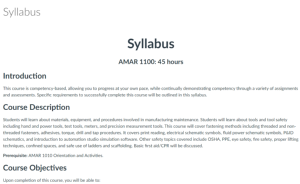Automation Technician Basics

Course Description:
This course, developed by Bridgerland Technical College, teaches students about the materials, equipment, and procedures involved in manufacturing maintenance. Students learn about tools and tool safety including hand and power tools, test tools, meters, and precision measurement tools. Fastening methods including threaded and non-threaded fasteners, adhesives, torque, and drill and tap procedures; print reading; electrical schematic symbols, fluid power schematic symbols, and P&ID schematics; an introduction to automation studio simulation software; OSHA; PPE; eye safety; fire safety; proper lifting techniques; confined spaces; and safe use of ladders and scaffolding are also covered. Basic first aid/CPR is discussed. Upon completing the course, students should be able to:
- use and identify basic tools, terminology, and safety practices;
- understand the language and symbols of blueprints, electrical schematics, fluid power schematics, and P&ID schematics;
- apply precision measurement techniques;
- use meters;
- recognize different materials and abrasives;
- understand fastening methods, threaded, nonthreaded, and adhesives;
- drill, tap, and properly torque threaded fasteners;
- use Automation Studio simulation software;
- demonstrate hands on skills through labs;
- apply best safety practices.
Course Contents:
Course materials include a Canvas .imscc file. The .imscc file includes numerous folders and files from the Canvas course, including a syllabus. The syllabus includes a course description, course objectives, and instructor and grading information.
This course includes 17 modules. Most modules include an introduction video and labs.
Below is a sample of modules and labs included in this course:
- Module 1: Orientation
- NSF Attribution
- Syllabus
- Canvas Orientation
- Submitting Assignments
- Welcome Video
- Module 2: Automation Studio
- Introduction to Automation Studio
- Automation Studio #1
- Automation Studio #2
- Automation Studio #3
- Automation Studio #4
- Automation Studio #5
- Module 3: Tools and Tool Safety
- Tools and Tool Safety Information Page/Overview
- Abrasives
- Module 4: Screwdrivers
- How To Use a Screwdriver Lab
- Module 5: Power Tools
- How to Use a Drill
- Drilling Holes with a Power Drill Lab
- Module 6: Laying out an Aluminum Workpiece
- How to Lay Out an Aluminum Workpiece Lab
- Module 7: Stamping
- How to Use a Steel Stamping Set Lab
- Module 8: Print Reading
- Introduction to Print Reading
- Description of Information Found on a Blueprint/Drawing
- Communicating Industrial Drawing Concepts
- How to Read and Draw Blueprint Lines
- Sectional Views on a Drawing
- Detail Assembly Drawings
- Looking at Different Drawings
- Module 9: Wires
- How to Use Wire Strippers Lab
- Module 10: File and Hack Saw
- How to Use a Hacksaw Lab
- How to Use a File Lab
- Module 11: How to Use a Pipe Wrench
- How to Use a Pipe Wrench and Pipe Tape Lab
- Module 12: Rivets
- How to Use a Pop Rivet Gun Lab
- Module 13: Drill and Tap
- How to Drill and Tap a Hole Lab
- How to Use a Die and chase threads on a bolt
- Module 14: Torque
- How to Use a Torque Wrench Lab
- Module 15: Bolts
- How to Remove a Broken Bolt Lab
- Module 16: Fastening Methods
- Fastener Methods
- Bolt Depot - Fasteners
- Anchors
- Eye Bolts & H, R, J, Sq, St Bolts
- Adhesives
- How to Assemble Using 80/20 Lab
- Module 17: Precision Measurement
- Precision Measurement
- Parts List
- Automation Technician Parts Without Prices
- Resources
- Abbr.pdf
- Alpline.pdf
- Engsys.pdf
- Equiv1.pdf
- Equiv2.pdf
- ergo for construction workers.pdf
- ergo nonpowered tools.pdf
- flu_power_abb.pdf
- flu_power_symb.pdf
- Metsys.pdf
- Prefix.pdf
About this Resource

Comments